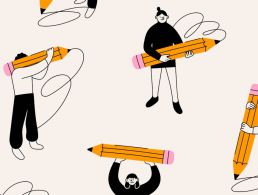Jonathan Løw of JumpStory reflects on his career path so far, from being a champion badminton player to living with depression and striving to change the face of the stock image industry.
Danish-born entrepreneur Jonathan Løw went from national badminton champion to the founder of a number of companies. But after living for a year with depression and having to leave a successful company behind, Løw decided to change tactics and dedicate his time to a sector he believes is propagating damaging stereotypes – photography.
His new venture – JumpStory – employs AI to source images that are “authentic, human and real”. So far, the business has raised around $1m in funding, with users signing up from more than 80 countries.
Here, Løw talks about his career path and why he’s passionate about changing up the faces we typically see in stock images.
What is your current role and what does it involve?
As co-founder of JumpStory, I have an incredibly interesting but also challenging role. My day-to-day work is everything from negotiating million-dollar contracts and investments to handling daily operational tasks or buying some beers for the team to celebrate reaching an important goal.
It’s really big and small combined, and it’s constant highs and lows. I sometimes describe that lifestyle as a combination of passion and panic but, luckily, it’s been mostly passion lately.
Was your career path a straightforward one?
No, not at all. I’ve never looked at my work life as a career. I think that such an outlook on life is very boring. It will mean that you apply for a certain education to get a certain job – but why?
So, you invest three to five years of your life to get a certain job, but perhaps that job might not even be your dream job? The same with applying for a position because it will look good on your CV. I really find that mentality sad. Instead, go for what motivates you 110pc, because then you can’t help becoming good at it, if you work hard enough.
I used to be a national champion in badminton, and I was not far away from becoming a professional athlete in my sport, but I lacked the last 5pc. Afterwards, I’ve used that elite sports mentality to keep pushing when things get rough. And it has taken me far, but it also involved remembering to take breaks – restitution – so you don’t get injuries in sport and burn out in business.
What made you realise it was time to step back from sports and business?
When I got my major depression, I was no longer an active athlete. However, I had two companies and I didn’t live a healthy lifestyle – too many Red Bulls and too little rest.
I actually have a lot of grit, so I wasn’t the vulnerable type, but everyone has a limit. I guess that I can push myself more than most, but it also meant that when I reached my breaking point, the valley was very, very deep.
When you’re generally a happy and positive person, depression feels so much stronger. What made me realise it? Crying in the shower. Feeling my heart beat crazy fast. All the classical symptoms that something is really, really wrong.
Was it difficult to come back having gone through a period of depression? Do you still live with depression?
Yes, it was tough. It takes time, and I’m not a very patient person. That is a good quality as an entrepreneur, because you make things get done, but when you are sick, it’s not necessarily the best combo.
So, it was a long and tough journey back. However, it also involved a lot of personal learning and today I’m really happy and live a much more balanced life.
I haven’t felt the depression for many years. I’ve learned how to look out for warning flags and drink less Red Bulls and rest more.
Do you have any advice for someone else going through a similar situation?
Firstly, you should not do business when you have depression. You should get well.
For me, the prayer for serenity was a really valuable reminder about the ups and downs in life and how to look at them in a different way. So, I would love to share that.
“God, grant me the serenity to accept the things I cannot change, the courage to change the things I can, and the wisdom to know the difference. Living one day at a time, enjoying one moment at a time; accepting hardship as a pathway to peace.”
What was your motivation behind setting up JumpStory?
I wanted to change an industry that I think is superficial and is creating stereotypes of human beings – the photo industry. We’ve raised more than $1m for JumpStory, and we use AI to source photos and videos that are authentic, human and real.
And it looks like we’re on the right path. Users from more than 80 countries have signed up to our platform, and business angels like the former Scandinavian CEO of Microsoft – Joergen Bardenfleth – have invested in our vision.
What sets JumpStory apart from other stock photo libraries and platforms?
The stock image industry is not only outdated, overpriced and overcomplicated, but it also strengthens some already terrible stereotypes about life and human beings.
Our technology is able to filter away most of the shallow and stereotypical images, so we can present marketers, agencies and our other customers with photos and videos that are actually real and human. This is good – not just for the marketers who will end up getting better results with their communication – but also for our perception of the world and what it should look like.
Some will probably focus on our flat-price business model, which is like Netflix and Spotify – just within our industry – but to me this is not just a matter of price. JumpStory has been put in this world to get rid of many of the stock photo-like images that support stereotypes, which are not healthy and also don’t work when it comes to marketing.
It’s a bit like what the charity industry experienced years ago, when suddenly people became immune to photos of starving children in third-world countries. This has happened to our industry in general, too.
Are there any resources that you would recommend to others?
After depression, read about people that inspire you. It can be biographies or novels. I’m personally inspired by everything from my dog Esther, because she is so amazing at being in the present, to Elon Musk, who is not a good leader but an amazing visionary.
Also, I would recommend The GuruBook, where 45 of the world’s leading entrepreneurs and innovators are interviewed and share their vision – but I should remember the disclaimer that I’m the editor of this book!




